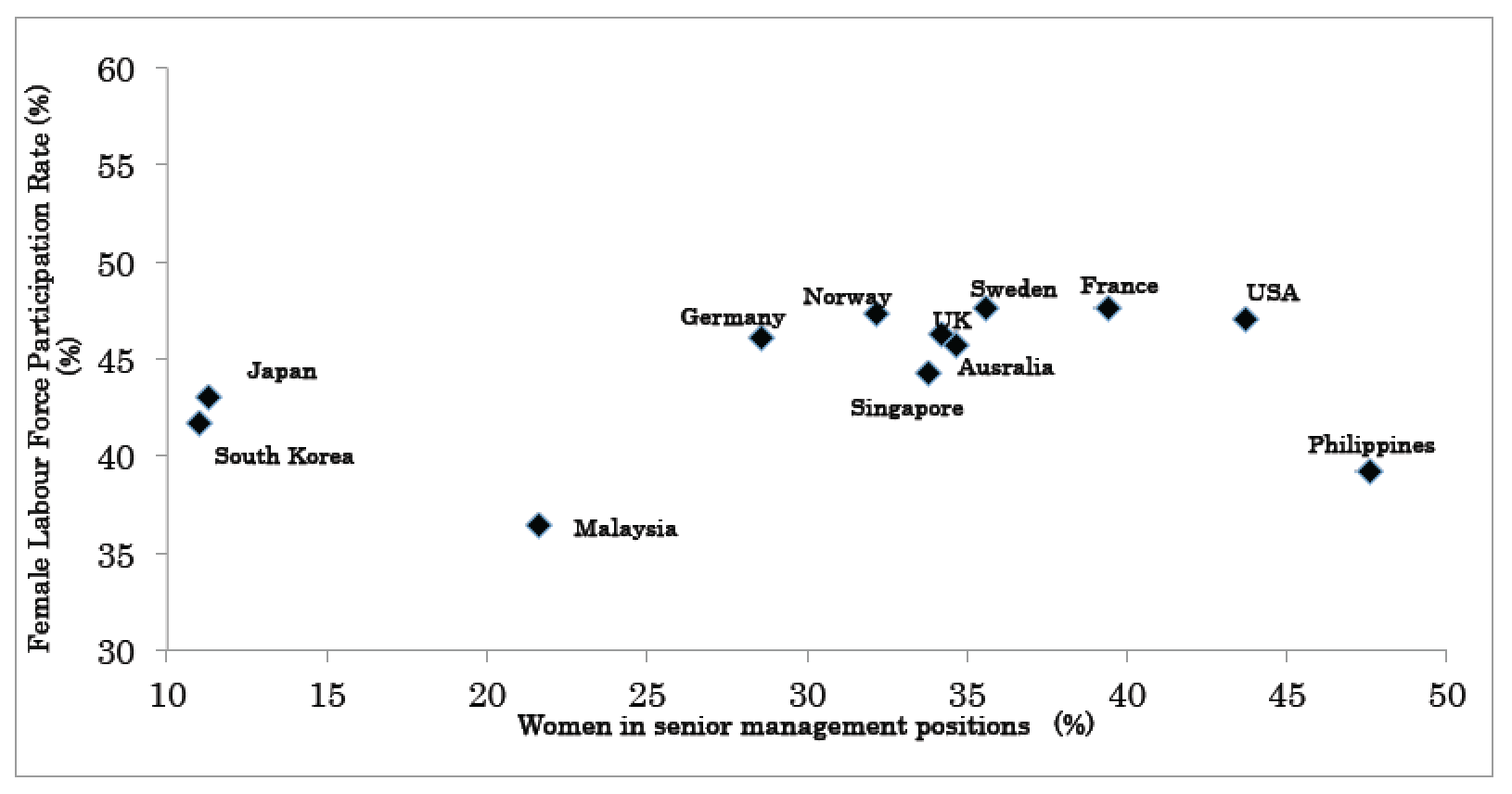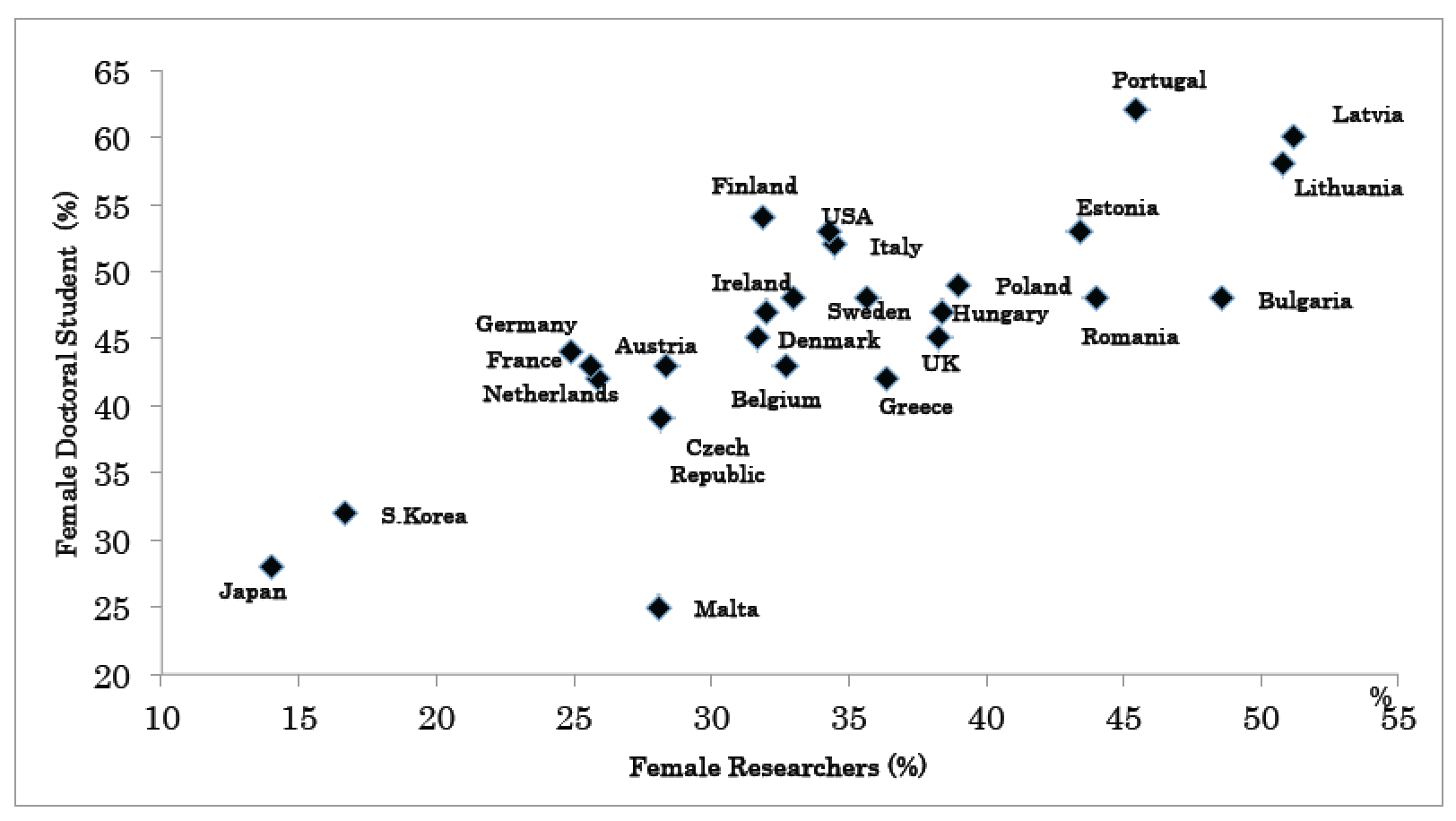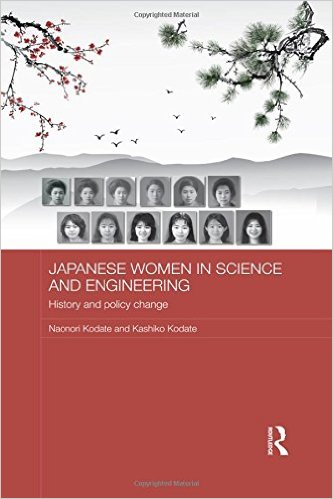Kashiko KODATE and Naonori KODATEWomen in Science and Engineering (Rikejo) - How policy changes occurred in Japan
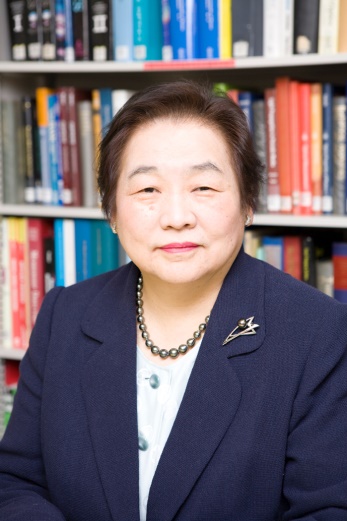 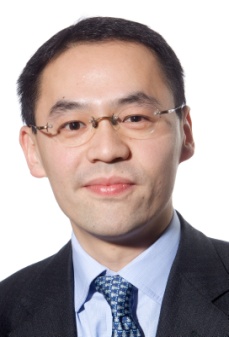 At Davos in January 2014, Prime Minister Abe stated that ‘Japan should be the place that gives women the opportunity to shine. Thirty per cent of leadership positions should be occupied by women by 2020’. Japan finally seems to be ready to embrace an increasingly global and competitive environment.
Nearly 30 years ago, the Equal Employment Opportunity Law (EEOL) was introduced to enable companies to fully utilise human resources regardless of gender. However, even in 2014, the proportion of female leaders in corporations was 11.3 per cent (see Figure 1 below).
Figure 1: Proportion of women in senior management positions and the labour market (selected countries) (Sources: Gender Equality Office, Cabinet Office, Japan, 2015, ‘Promoting Women in Society’. Note: the definition of ‘senior management positions’ varies.)
The situation in academia is similar, as the proportion of female researchers is still one of the lowest among OECD countries (14.6 per cent as of 2014). The number of Japanese women in science, technology, engineering and mathematics (STEM) remains particularly low (see Figure 2 below).
Although the gender gap in STEM varies greatly from country to country, this prompts us to ask why the proportion of female scientists in Japan is still remarkably low, and what measures the government, universities and research institutes are taking to address this issue.
Figure 2: Proportion of female researchers and doctoral students (selected countries) (Sources: Kodate and Kodate 2015, p.76)
Our book, Japanese Women in Science and Engineering: History and Policy Change sheds light on historical developments and the current gender equality situation in Japan, through the lens of women in STEM. It shows not only how a policy of gender equality in STEM has been introduced through the coordinated efforts of academia, scientific societies and the government, but also how the progress facing women in STEM has been intertwined with social norms, family and individual life decisions and policies on issues such as education and the labour market.
The remainder of this “Carnet de chercheur” will provide a brief summary of the book.
International studies highlight the fact that the obstacles facing women in STEM are multifaceted and must be carefully examined through the lens of life-cycle stages (Blickenstaff 2005; Castaño and Webster 2011; European Commission 2009; Herman and Webster 2010).
The slow progress in achieving gender equality in STEM has fuelled discussions about the underrepresentation of women in the field (Wennerås and Wold 1997; Hill et al. 2010), and the overall opinion is that in order to see desirable changes occur, a rather long-term process of implementing various reforms is required, including addressing biases in society (Moss-Racusin et al. 2012). In some countries where women are not encouraged to remain in the labour market, these changes may take longer than in other countries (Sjöberg 2010).
As Clark (2008) points out in a description of women’s achievements and struggles in 19th-century Europe, women’s access to a professional career was first restricted due to access to education being denied them for a long time. Once the equal right to education was granted to women, then the next step was to open the door to a professional career: nursing, teaching, medicine, the legal profession, and public sector jobs. There is a great difference from country to country in the way in which women’s access to various professions was regulated and gradually adjusted as women began trying to enter. It also greatly mattered how society perceived women having a professional career.
Although most of the early female scientists in Japan chose to remain in education while carrying out their research, the link between education and the prospect of a future career as well as that of work-life balance has always been important.
Therefore, questions still remain as to how closely government policies to bring about gender equality in STEM are aligned with the practices and aspirations of other stakeholders (e.g. companies, education institutions, and parents/individuals), what the government’s priorities are, and who plays a major role in implementing these policies (Kodate et al. 2010). These are crucial questions for understanding not only the politics of gender equality, but also those of welfare states in transition, as the gender balance in these societies has major implications for education, for the economy and moreover, for the overall shape of each such country in the future (i.e. demographic changes) (O’Connor et al. 1999; Estévez-Abe et al. 2001; Iversen et al. 2005; McCall and Orloff 2005).
This book addresses these questions by outlining the history and recent developments in Japan in terms of government and academic community initiatives for supporting female students and researchers in STEM.
The book explains how formal institutional arrangements for Japanese women in STEM were shaped at the end of the 19th century and in the early 20th century, and were reformed at different ‘critical junctures’ (Collier and Collier 1991; Pierson 2004).
This book is divided into three phases, making use of those critical junctures. The 1st phase deals with women’s access to education and research in STEM. The 2nd phase starts with the end of the Second World War (WWII), when women were allowed to enter the former Imperial Universities, such as the University of Tokyo and Kyoto University. This phase ends in the mid-1980s, when equal opportunities at the workplace were rather half-heartedly forced upon companies. The 3rdphase deals with the beginning of a gradual policy change in the Japanese political economy landscape and also gender equality in society.
The book found three factors that could explain the relative slowness in the advancement of women in STEM in Japan. The first factor is a reactive nature, in general, to the adoption of Western values that were equated with modernisation of the country by the government over a long period of time. Later on, a pattern developed in which international pressure had to beleveraged to bring in policy measures to reduce gender inequality. The second factor is the speed at which changes were made to institutional arrangements in wider society (e.g. political system, education and workplace practices). As a result, traditional cultural norms persisted over many decades. The third factor is the lack of a concerted effort among the academic community in tackling the issue of gender inequality. Several initiatives were required of the academic community before the general recognition of underrepresentation of women within STEM fields were turned into policy actions.
This book highlights how policies for supporting women in STEM have been guided by the concept of ‘equal participation of men and women’ (Danjo Kyōdo Sankaku Kyoku) in the mid-1990s onwards. In Japan, the concept of ‘gender equality’ has not become widely prevalent and as strongly championed as in most Western feminist movements, which have brought about changes in laws and social practices over many years. ‘Gender equality’ emphasises the importance of individual freedom from gender stereotypes. Although there have been several waves of women’s movements for social advancement in Japan, ‘gender equality’ has never become embraced by mainstream policymakers in Japan, and the STEM policy was no exception.
In contrast, ‘equal participation’ was adopted widely since the early 1990s. The emphasis in the latter concept is placed upon a collective contribution to society as a group rather than in terms of individual achievements. This concept of ‘equal participation’ has played a major part in bringing about several major policy changes in the late 1990s and the early 2000s.
This book consists of an introduction, five main chapters and a conclusion. Chapter 1 describes the history of the establishment of the modern education system in Japan from the beginning of the Meiji era until WWII. The foundation of the Japanese school system is outlined, with a particular focus on the development of women’s access to higher and science education. Chapter 2 depicts the higher educational landscape in post-WWII Japan, highlighting the government’s move towards a co-educational system, and the widening access of women to higher education. The chapter examines policy developments in terms of women’s rights, leading up to the EEOL in 1986. The significant problem of the underrepresentation of women in STEM and the activities of academic societies in scientific fields during that period are also addressed. Chapter 3 then looks at the impacts of the EEOL and the developments during the period between 1986 and 1999, when the Basic Law for a Gender-Equal Society was enacted. The Liberal Democratic Party governed Japan for 38 years from 1955 to 1993, when the so-called 1955 regime came to an end. Simultaneously, as the economic bubble burst, many attributes of the post-WWII Japanese model began to be questioned. The educational attainment of women grew significantly during this period, and more women were enrolled in a 4-year university course, rather than a 2-year college course. The increase in the number of women entering Colleges of Technology is also noted, and their survey results reveal how life choice patterns changed over time for different generations who graduated before and after the EEOL. The meaning of education and its link to a career began to change for women during this period.
Chapter 4 describes the two important changes prior to the policy change in the mid-2000s. One is government reorganisation, which took place in early 2000, and another is the formation of a liaison group of various professional societies in order to bring about changes to the situation of women in STEM. The chapter outlines a number of policies which were introduced to ameliorate the underrepresentation of women in STEM. Chapter 5 focuses on the evaluation of government policies in the last 8 years, based on the questionnaire results of the professional societies and of higher education institutions. Voices of women in STEM (alumnae from universities, and those active in research and industry) are also highlighted, in order to contrast them with the focus of macro-level policies on the ‘why so few’ (quantity) question. The book identifies multiple career paths that are now open to women in STEM, which was unthinkable 40 years ago.
The book draws on extensive data including interviews with government officials, scientists and educators in Japan to provide a revealing case study on how the underrepresentation of women in the fields of science, technology and engineering has been approached and dealt with by a national government. It heralds a new era for female scientists, by showcasing several programmes undertaken by government, universities and national research institutions to support multiple career paths for and the progression of female scientists in Japan.
There is no question that a greater number of opportunities are available for Japanese women than previously. However, the hurdles that they come up against may still remain high, accompanying many personal and family sacrifices, irrespective of the mainstreaming of equality policies. Also, although there has been a positive shift in men’s attitudes towards childrearing, government’s over-emphasis on economic growth, targeting women as the precious source of labour and skills may lead to a further fragmentation of collective identity among women in general, and women in STEM. A strong force deriving from the global market and competition may signify that only highly qualified and elite women are treated almost as equals, leaving others behind. Therefore, while we have reasons for optimism for women in STEM, we need to closely monitor the situation of gender balance in general over a long period of time. Future research is absolutely necessary in capturing new types of social risks that may or may not be protected by the state or market.
Based on Naonori Kodate & Kashiko Kodate, Japanese Women in Science and Engineering: History and Policy Change, Routledge, 2015.
|
| Inscrivez-vous à notre Lettre en cliquant ici |
*En cas de problème, vous pouvez aussi vous inscrire en envoyant un mail à sympa@ehess.fr, avec pour titre "subscribe ffj_french_news".






